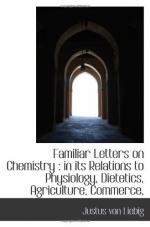If we suppose selenium to be merely modified sulphur, and phosphorus modified arsenic, how does it happen, we must inquire, that sulphuric acid and selenic acid, phosphoric and arsenic acid, respectively form compounds which it is impossible to distinguish by their form and solubility? Were these merely isomeric, they ought to exhibit properties quite dissimilar!
We have not, I believe, at present the remotest ground to suppose that any one of those substances which chemists regard as elements can be converted into another. Such a conversion, indeed, would presuppose that the element was composed of two or more ingredients, and was in fact not an element; and until the decomposition of these bodies is accomplished, and their constituents discovered, all pretensions to such conversions deserve no notice.
Dr. Brown of Edinburgh thought he had converted iron into rhodium, and carbon or paracyanogen into silicon. His paper upon this subject was published in the Transactions of the Royal Society of Edinburgh, and contained internal evidence, without a repetition of his experiments, that he was totally unacquainted with the principles of chemical analysis. But his experiments have been carefully repeated by qualified persons, and they have completely proved his ignorance: his rhodium is iron, and his silicon an impure incombustible coal.
LETTER VI
My dear Sir,
One of the most remarkable effects of the recent progress of science is the alliance of chemistry with physiology, by which a new and unexpected light has been thrown upon the vital processes of plants and animals. We have now no longer any difficulty in understanding the different actions of aliments, poisons, and remedial agents—we have a clear conception of the causes of hunger, of the exact nature of death; and we are not, as formerly, obliged to content ourselves with a mere description of their symptoms. It is now ascertained with positive certainty, that all the substances which constitute the food of man must be divided into two great classes, one of which serves for the nutrition and reproduction of the animal body, whilst the other ministers to quite different purposes. Thus starch, gum, sugar, beer, wine, spirits, &c., furnish no element capable of entering into the composition of blood, muscular fibre, or any part which is the seat of the vital principle. It must surely be universally interesting to trace the great change our views have undergone upon these subjects, as well as to become acquainted with the researches from which our present knowledge is derived.
The primary conditions of the maintenance of animal life, are a constant supply of certain matters, animal food, and of oxygen, in the shape of atmospheric air. During every moment of life, oxygen is absorbed from the atmosphere in the organs of respiration, and the act of breathing cannot cease while life continues.




